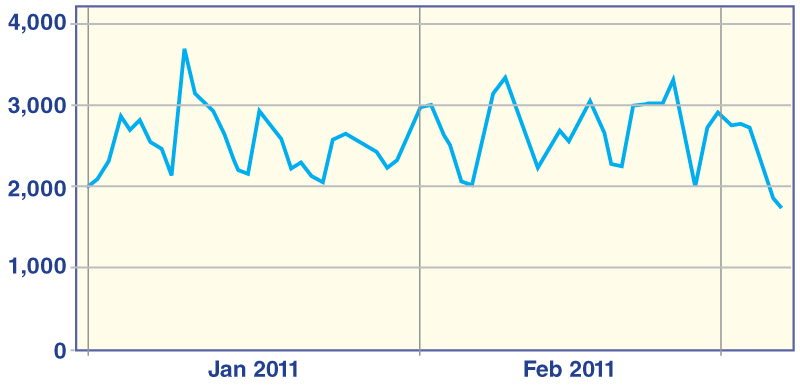â–¶ March Madness Turns Social: Nearly one in four online American adults (23%) revealed that they will be using some form of social media to follow this year’s men’s NCAA Tournament, says new research from IMRE Sports, and conducted on their behalf by Harris Interactive. Additional findings include:
• 50% will use social networking sites; 31% will specifically use YouTube; and 27% will use a mobile application.
• Men will be more likely than women to use social media to follow March Madness, by a margin of 3 to 1 (32% men vs. 14% women).
• As to how fans will use social media platforms, 62% will use social media channels specifically to check the scores; 44% will use them to watch the games; 44% will use them to follow their favorite team/college; 40% will use them to follow their own bracket/other gaming purposes; and 19% will utilize social media channels to follow their favorite player/coach.
Source: IMRE Sports
 |
| With the price of gas rising steadily, data compiled by WiseWindow—and exclusive to PR News—finds U.S. chatter (vertical axis represents thousands of people) on the topic from January to March to be surprisingly low-key. WiseWindow tracked conversations on Facebook, microblogs (Twitter), blogs, message boards, video and reviews. Source: WiseWindow |
â–¶ Smaller Boards—Better Business Success: PR pros looking to get a seat at the table might want to count the number of chairs first. Smaller boards, more female directors and a higher proportion of independent directors are the key boardroom components for company success, with U.S. boards closely matching the global success trends, according to a global study of 250 top companies between October 2009 and December 2009 by international law firm Eversheds. Other findings include:
• The optimum size for a successful U.S. board is considered to be directors, in line with the global optimum size of 11.
• Companies that have more female directors performed better during the financial crisis. This is the case in the U.S., which has the highest proportion of female directors (17.6% in 2007 and 17.0% in 2009).
• However, when interviewed, only 55% of directors feel that diversity for its own sake was beneficial for board and company performance, and only half that number are directly in favor of taking positive action to appoint more women onto boards.
• There is a strong correlation between share price performance and the number of independent directors on company boards. Directors narrowly preferred independence to experience. However, 67% believed both were equally important.
Source: Eversheds
â–¶ Beware the Bad News: Consumers have sounded a clear warning to brands in loyalty marketing services firm Colloquy’s research into the word-of-mouth sharing practices of U.S. households: Bad news travels fast. Of 3,295 U.S. consumers surveyed, slightly more than one out of every four (26%) said they are far more likely to spread the word to family, friends and coworkers about a bad experience with a product or service than a good one. Other findings include:
• Of “WOM champions,” a group that is most loyal and engaged with a brand, 31% say they are far more likely to share information about a bad experience with a product or service than a good one.
• Affluent consumers, at 30%, score highest for saying they’re far more likely to spread a bad experience. Seniors score the lowest at 19%.
• Just 7% of the general population are “Pure Madvocates” —consumers who aren’t connected to brands and aren’t willing to advocate for them, but who are oriented to negative WOM.
Source: Colloquy
â–¶ Public Not Just Talking on Mobile Phones: According to the comScore 2010 Mobile Year in Review report, mobile media adoption has continued to grow throughout the past year as consumers are increasingly turning to their mobile phones for many other uses beyond just talking or texting. Since December 2009 the number of mobile media users has grown significantly in the U.S., as 109 million U.S. mobile subscribers accessed mobile media in December 2010, up 7.6 percentage points versus a year ago. Specific findings include:
• Social networking is the fastest-growing mobile content category in the U.S.: Nearly 58 million mobile subscribers accessed a social networking site at least monthly via mobile device as of December 2010, up 56% from the previous year.
• Specifically, Facebook usage is up 121% over the previous year. YouTube and Twitter held the second and third position in the U.S., growing 74% and 71%, respectively, whereas the number of users accessing MySpace via mobile fell 20% in the U.S.
• Classifieds was the second-strongest mobile content growth category, reaching nearly 17 million mobile subscribers as of December, up 55% over the previous year, followed by online retail sites, up 53%.
Source: comScore
